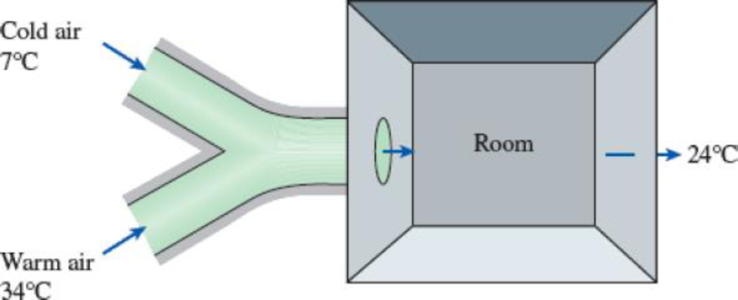
An air-conditioning system involves the mixing of cold air and warm outdoor air before the mixture is routed to the conditioned room in steady operation. Cold air enters the mixing chamber at 7°C and 105 kPa at a rate of 0.55 m3/s while warm air enters at 34°C and 105 kPa. The air leaves the room at 24°C. The ratio of the mass flow rates of the hot to cold airstreams is 1.6. Using variable specific heats, determine (a) the mixture temperature at the inlet of the room and (b) the rate of heat gain of the room.
FIGURE P5–83

(a)
The mixture temperature at the inlet of the room.
Answer to Problem 83P
The mixture temperature at the inlet of the room is
Explanation of Solution
Here, the warm and cold streams of fluids are mixed in a rigid mixing chamber and operates at steady state. Hence, the inlet and exit mass flow rates are equal.
Write the energy rate balance equation for two inlet and one outlet system.
Here, the rate of heat transfer is
The system is at steady state. Hence, the rate of change in net energy of the system becomes zero.
Neglect the heat transfer, work transfer, kinetic and potential energies.
The Equation (II) reduced as follows.
Substitute
Here, the ratio of mass flow rate of hot to cold air streams is
Substitute
Refer Table A-17, “Ideal-gas properties of air”
Obtain the enthalpy
Obtain the enthalpy
Write the formula of interpolation method of two variables.
Show the temperature and enthalpy values from the Table A-17 as in below table.
| S.No. | x | y |
| Temperature | enthalpy | |
| 1 | 305 | 305.22 |
| 2 | 307 | ? |
| 3 | 310 | 310.24 |
Substitute
Thus, the enthalpy
Similarly,
Obtain the enthalpy
Conclusion:
Substitute
Refer Table A-17, “Ideal-gas properties of air”
Obtain the temperature
Show the temperature and enthalpy values from the Table A-17 as in below table.
| S.No. | x | y |
| Enthalpy | Temperature | |
| 1 | 295.17 | 295 |
| 2 | 296.8096 | ? |
| 3 | 298.18 | 298 |
Substitute
The temperature
Thus, the mixture temperature at the inlet of the room is
(b)
The rate of heat gain of the room.
Answer to Problem 83P
The rate of heat gain of the room is
Explanation of Solution
Write the formula for mass flow rate of cold air
Here, the volumetric flow rate of air is
Express the formula for heat gain by the room.
Here, the mass flow rate of mixed air entering the room is
Refer Table A-1, “Molar mass, gas constant, and critical-point properties”.
The gas constant of air is
Conclusion:
Substitute
Substitute
Substitute
Thus, the rate of heat gain of the room is
Want to see more full solutions like this?
Chapter 5 Solutions
THERMODYNAMICS(SI UNITS,INTL.ED)EBOOK>I
- My ID#016948724 please solve this problems and show me every step clear to follow pleasearrow_forwardMy ID# 016948724arrow_forwardPlease do not use any AI tools to solve this question. I need a fully manual, step-by-step solution with clear explanations, as if it were done by a human tutor. No AI-generated responses, please.arrow_forward
- Please do not use any AI tools to solve this question. I need a fully manual, step-by-step solution with clear explanations, as if it were done by a human tutor. No AI-generated responses, please.arrow_forwardPlease do not use any AI tools to solve this question. I need a fully manual, step-by-step solution with clear explanations, as if it were done by a human tutor. No AI-generated responses, please.arrow_forward[Q2]: The cost information supplied by the cost accountant is as follows:Sales 20,00 units, $ 10 per unitCalculate the (a/ newsale guantity and (b) new selling price to earn the sameVariable cost $ 6 per unit, Fixed Cost $ 30,000, Profit $ 50,000profit ifi) Variable cost increases by $ 2 per unitil) Fixed cost increase by $ 10,000Ili) Variable cost increase by $ 1 per unit and fixed cost reduces by $ 10,000arrow_forward
- can you please help me perform Visual Inspection and Fractography of the attatched image: Preliminary examination to identify the fracture origin, suspected fatigue striation, and corrosion evidences.arrow_forwardcan you please help[ me conduct Causal Analysis (FTA) on the scenario attatched: FTA diagram which is a fault tree analysis diagram will be used to gain an overview of the entire path of failure from root cause to the top event (i.e., the swing’s detachment) and to identify interactions between misuse, material decay and inspection errors.arrow_forwardhi can you please help me in finding the stress intensity factor using a k-calcluator for the scenario attathced in the images.arrow_forward
 Elements Of ElectromagneticsMechanical EngineeringISBN:9780190698614Author:Sadiku, Matthew N. O.Publisher:Oxford University Press
Elements Of ElectromagneticsMechanical EngineeringISBN:9780190698614Author:Sadiku, Matthew N. O.Publisher:Oxford University Press Mechanics of Materials (10th Edition)Mechanical EngineeringISBN:9780134319650Author:Russell C. HibbelerPublisher:PEARSON
Mechanics of Materials (10th Edition)Mechanical EngineeringISBN:9780134319650Author:Russell C. HibbelerPublisher:PEARSON Thermodynamics: An Engineering ApproachMechanical EngineeringISBN:9781259822674Author:Yunus A. Cengel Dr., Michael A. BolesPublisher:McGraw-Hill Education
Thermodynamics: An Engineering ApproachMechanical EngineeringISBN:9781259822674Author:Yunus A. Cengel Dr., Michael A. BolesPublisher:McGraw-Hill Education Control Systems EngineeringMechanical EngineeringISBN:9781118170519Author:Norman S. NisePublisher:WILEY
Control Systems EngineeringMechanical EngineeringISBN:9781118170519Author:Norman S. NisePublisher:WILEY Mechanics of Materials (MindTap Course List)Mechanical EngineeringISBN:9781337093347Author:Barry J. Goodno, James M. GerePublisher:Cengage Learning
Mechanics of Materials (MindTap Course List)Mechanical EngineeringISBN:9781337093347Author:Barry J. Goodno, James M. GerePublisher:Cengage Learning Engineering Mechanics: StaticsMechanical EngineeringISBN:9781118807330Author:James L. Meriam, L. G. Kraige, J. N. BoltonPublisher:WILEY
Engineering Mechanics: StaticsMechanical EngineeringISBN:9781118807330Author:James L. Meriam, L. G. Kraige, J. N. BoltonPublisher:WILEY





